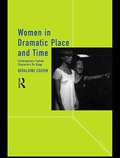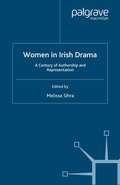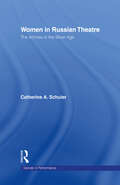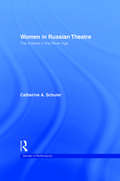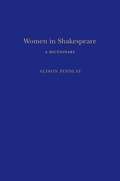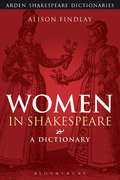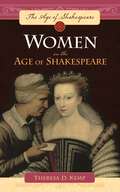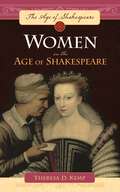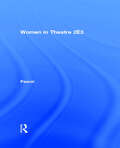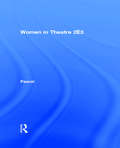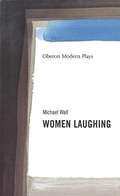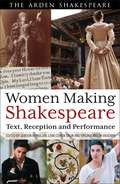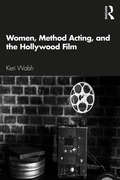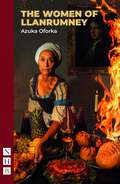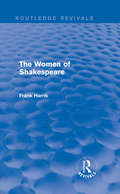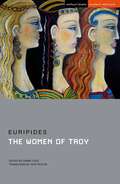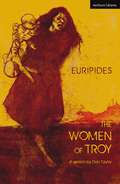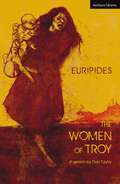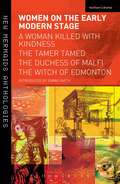- Table View
- List View
Women in Dramatic Place and Time: Contemporary Female Characters on Stage
by Geraldine CousinFirst published in 1996. Routledge is an imprint of Taylor & Francis, an informa company.
Women in Dramatic Place and Time: Contemporary Female Characters on Stage
by Geraldine CousinFirst published in 1996. Routledge is an imprint of Taylor & Francis, an informa company.
Women in Irish Drama: A Century of Authorship and Representation (Performance Interventions)
by M. SihraFeaturing original essays by leading scholars in the field, this book explores the immense legacy of women playwrights in Irish theatre since the beginning of theTwentieth century. Chapters consider the intersecting contexts of gender, sexuality and the body in order to investigate the broader cultural, political and historical implications of representing 'woman' on the stage. In addition, a number of essays engage with representations of women by a selection of male playwrights in order to re-evaluate familiar contexts and traditions in Irish drama. Features a Foreword by Marina Carr and a useful appendix of Irish women playwrights and their works.
Women in Russian Theatre: The Actress in the Silver Age (Gender in Performance)
by Catherine SchulerWomen in Russian Theatre is a fascinating feminist counterpoint to the established area of Russian theatre populated by male artists such as Stanislavsky, Chekov and Meyerhold. With unprecedented access to newly-opened files in Russia, Catherine Schuler brings to light the actresses who had an impact upon Russian modernist theatre. Schuler brings to light the extradordinary lives and work of eight Russian actresses who flourished on the stage between the late nineteenth and early twentieth century.
Women in Russian Theatre: The Actress in the Silver Age (Gender in Performance)
by Catherine SchulerWomen in Russian Theatre is a fascinating feminist counterpoint to the established area of Russian theatre populated by male artists such as Stanislavsky, Chekov and Meyerhold. With unprecedented access to newly-opened files in Russia, Catherine Schuler brings to light the actresses who had an impact upon Russian modernist theatre. Schuler brings to light the extradordinary lives and work of eight Russian actresses who flourished on the stage between the late nineteenth and early twentieth century.
Women in Shakespeare: A Dictionary (Continuum Shakespeare Dictionaries)
by Alison FindlayWomen in Shakespeare: A Dictionary is a comprehensive reference guide to Shakespeare and women. An A-Z of over 350 entries explores the role of women within Shakespearean drama, how women were represented on the Shakespearean stage, and the role of women in Shakespeare's personal and professional lives. Women in Shakespeare examines in detail the language employed by Shakespeare in his representation of women in the full range of his poetry and plays and the implications these representations have for the position of women in Elizabethan and Jacobean society. Women in Shakespeare is an ideal guide to Shakespeare's women for all students and scholars of Shakespeare.
Women in Shakespeare: A Dictionary (Arden Shakespeare Dictionaries)
by Alison FindlayThis is a comprehensive reference guide examining the language employed by Shakespeare to represent women in the full range of his poetry and plays. Including over 350 entries, Alison Findlay shows the role of women within Shakespearean drama, their representations on the Shakespearean stage, and their place in Shakespeare's personal and professional lives.
Women in the Age of Shakespeare (The Age of Shakespeare)
by Theresa D. KempThis book offers a look at the lives of Elizabethan era women in the context of the great female characters in the works of William Shakespeare.Like the other entries in this fascinating series, Women in the Age of Shakespeare shows the influence of the world William Shakespeare lived in on the worlds he created for the stage, this time by focusing on women in the Elizabethan and Jacobean eras in general and in Shakespeare's works in particular.Women in the Age of Shakespeare explores the ancient and medieval ideas that Shakespeare drew upon in creating his great comedic and tragic heroines. It then looks at how these ideas intersected with the lived experiences of women of Shakespeare's time, followed by a close look at the major female characters in Shakespeare's plays and poems. Later chapters consider how these characters have been enacted on stage and in film, interpreted by critics and scholars, and re-imagined by writers in our own time.
Women in the Age of Shakespeare (The Age of Shakespeare)
by Theresa D. KempThis book offers a look at the lives of Elizabethan era women in the context of the great female characters in the works of William Shakespeare.Like the other entries in this fascinating series, Women in the Age of Shakespeare shows the influence of the world William Shakespeare lived in on the worlds he created for the stage, this time by focusing on women in the Elizabethan and Jacobean eras in general and in Shakespeare's works in particular.Women in the Age of Shakespeare explores the ancient and medieval ideas that Shakespeare drew upon in creating his great comedic and tragic heroines. It then looks at how these ideas intersected with the lived experiences of women of Shakespeare's time, followed by a close look at the major female characters in Shakespeare's plays and poems. Later chapters consider how these characters have been enacted on stage and in film, interpreted by critics and scholars, and re-imagined by writers in our own time.
Women in Theatre 2#3 (Contemporary Theatre Review Ser.)
by Julia PascalFirst Published in 1996. Routledge is an imprint of Taylor & Francis, an informa company.
Women in Theatre 2#3
by Julia PascalFirst Published in 1996. Routledge is an imprint of Taylor & Francis, an informa company.
Women Laughing (Oberon Modern Playwright's Ser.)
by Michael WallThere are many fleeting moments when either Colin or Tony want to smother the laughs of their wives. The two couples fight for every inch of their lives, from the garden of a house in Ealing to the grounds of a mental asylum. Women Laughing has been performed at the Royal Exchange Manchester, the Royal Court Theatre Upstairs, the Palace Theatre Watford and was toured in 2000 by Not The National Theatre.
Women Making Shakespeare: Text, Reception and Performance
by Edited by Gordon McMullan Lena Cowen Orlin Virginia Mason VaughanWomen Making Shakespeare presents a series of 20-25 short essays that draw on a variety of resources, including interviews with directors, actors, and other performance practitioners, to explore the place (or constitutive absence) of women in the Shakespearean text and in the history of Shakespearean reception - the many ways women, working individually or in communities, have shaped and transformed the reception, performance, and teaching of Shakespeare from the 17th century to the present. The book highlights the essential role Shakespeare's texts have played in the historical development of feminism. Rather than a traditional collection of essays, Women Making Shakespeare brings together materials from diverse resources and uses diverse research methods to create something new and transformative. Among the many women's interactions with Shakespeare to be considered are acting (whether on the professional stage, in film, on lecture tours, or in staged readings), editing, teaching, academic writing, and recycling through adaptations and appropriations (film, novels, poems, plays, visual arts).
Women Making Shakespeare: Text, Reception and Performance
by Gordon McMullan Lena Cowen Orlin Virginia Mason VaughanWomen Making Shakespeare presents a series of 20-25 short essays that draw on a variety of resources, including interviews with directors, actors, and other performance practitioners, to explore the place (or constitutive absence) of women in the Shakespearean text and in the history of Shakespearean reception - the many ways women, working individually or in communities, have shaped and transformed the reception, performance, and teaching of Shakespeare from the 17th century to the present. The book highlights the essential role Shakespeare's texts have played in the historical development of feminism. Rather than a traditional collection of essays, Women Making Shakespeare brings together materials from diverse resources and uses diverse research methods to create something new and transformative. Among the many women's interactions with Shakespeare to be considered are acting (whether on the professional stage, in film, on lecture tours, or in staged readings), editing, teaching, academic writing, and recycling through adaptations and appropriations (film, novels, poems, plays, visual arts).
Women, Method Acting, and the Hollywood Film
by Keri WalshWomen, Method Acting, and the Hollywood Film is the first study dedicated to understanding the work of female Method actors on film. While Method acting on film has typically been associated with the explosive machismo of actors like Marlon Brando and Robert De Niro, this book explores an alternate tradition within the Method—the work that women from the Actors Studio did in Hollywood. Covering the period from the end of the Second World War until the 1970s, this study shows how the women associated with the Actors Studio increasingly used Method acting in ways that were compatible with their burgeoning feminist political commitments and developed a style of feminist Method acting. The book examines the complex intersection of Method acting, sexuality, and gender by analyzing performances such as Kim Hunter’s in A Streetcar Named Desire, Julie Harris’s in The Member of the Wedding, Shelley Winters’s in The Big Knife, Geraldine Page’s in Sweet Bird of Youth, and Jane Fonda’s in Coming Home. Challenging the longstanding assumption that Method acting’s approaches were harmful to women and incompatible with feminism, this book argues that some of Hollywood’s most interesting female actors, and leading feminists, emerged from the Actors Studio in the period between the 1950s and the 1970s. Written for students and scholars of Film Studies, Cultural Studies, Theatre and Performance Studies, and Gender Studies, Women, Method Acting, and the Hollywood Film reshapes the way we think of a central strain in American screen acting, and in doing so, allows women a new stake in that tradition.
Women, Method Acting, and the Hollywood Film
by Keri WalshWomen, Method Acting, and the Hollywood Film is the first study dedicated to understanding the work of female Method actors on film. While Method acting on film has typically been associated with the explosive machismo of actors like Marlon Brando and Robert De Niro, this book explores an alternate tradition within the Method—the work that women from the Actors Studio did in Hollywood. Covering the period from the end of the Second World War until the 1970s, this study shows how the women associated with the Actors Studio increasingly used Method acting in ways that were compatible with their burgeoning feminist political commitments and developed a style of feminist Method acting. The book examines the complex intersection of Method acting, sexuality, and gender by analyzing performances such as Kim Hunter’s in A Streetcar Named Desire, Julie Harris’s in The Member of the Wedding, Shelley Winters’s in The Big Knife, Geraldine Page’s in Sweet Bird of Youth, and Jane Fonda’s in Coming Home. Challenging the longstanding assumption that Method acting’s approaches were harmful to women and incompatible with feminism, this book argues that some of Hollywood’s most interesting female actors, and leading feminists, emerged from the Actors Studio in the period between the 1950s and the 1970s. Written for students and scholars of Film Studies, Cultural Studies, Theatre and Performance Studies, and Gender Studies, Women, Method Acting, and the Hollywood Film reshapes the way we think of a central strain in American screen acting, and in doing so, allows women a new stake in that tradition.
The Women of Llanrumney (Nhb Modern Plays Ser.)
by Azuka OforkaLlanrumney plantation. Saint Mary Parish, Jamaica. 1765. Annie and Cerys are enslaved by the Morgan family from Wales. When Elizabeth Morgan is faced with the loss of her plantation, the slaves' future hangs in the balance. With a storm of rebellion brewing, Annie does everything she can to secure her future. But sooner or later she will have to face up to the horror and trauma all around her, including her own. Azuka Oforka's play The Women of Llanrumney is a powerful, searing drama that explores the impact of slavery and the lives of women who experienced it – those who benefitted from it, those who were brutalised by it and those who fought to destroy it. It premiered at Sherman Theatre, Cardiff, in 2024, directed by Patricia Logue.
The Women of Shakespeare (Routledge Revivals)
by Frank HarrisFrank Harris argues that the way women are presented in Shakespeare’s plays and sonnets are a reflection of the real-life women in his life, namely his wife, mother, mistress and daughter. Originally published in 1911, The Women of Shakespeare also analyses the traditional criticism of the time and places his own views in this context. This title will be of interest to students of English Literature.
The Women of Shakespeare (Routledge Revivals)
by Frank HarrisFrank Harris argues that the way women are presented in Shakespeare’s plays and sonnets are a reflection of the real-life women in his life, namely his wife, mother, mistress and daughter. Originally published in 1911, The Women of Shakespeare also analyses the traditional criticism of the time and places his own views in this context. This title will be of interest to students of English Literature.
The Women of Troy (Student Editions)
by EuripidesThere's no decent way to say an indecent thingAn industrial port of a war-torn city. Women survivors wait to be shipped abroad. Officials come and go. A grandmother, once queen, watches as her remaining family are taken from her one by one. The city burns around them. First performed in 415BC, the play focuses on the human cost of war and the impact of loss.This new Student Edition of The Women of Troy includes a commentary and notes by Emma Cole, which looks at the Trojan War as represented in Greek literature and myth; the context in which Euripides was writing and within which the play was first performed; how it would have been originally staged and dramaturgical challenges met; as well as recent performance history of the play, including Katie Mitchell's iconic 2007 production at the National Theatre. Euripides' great anti-war play is published here in Don Taylor's classic translation.
The Women of Troy (Student Editions)
by EuripidesThere's no decent way to say an indecent thingAn industrial port of a war-torn city. Women survivors wait to be shipped abroad. Officials come and go. A grandmother, once queen, watches as her remaining family are taken from her one by one. The city burns around them. First performed in 415BC, the play focuses on the human cost of war and the impact of loss.This new Student Edition of The Women of Troy includes a commentary and notes by Emma Cole, which looks at the Trojan War as represented in Greek literature and myth; the context in which Euripides was writing and within which the play was first performed; how it would have been originally staged and dramaturgical challenges met; as well as recent performance history of the play, including Katie Mitchell's iconic 2007 production at the National Theatre. Euripides' great anti-war play is published here in Don Taylor's classic translation.
The Women of Troy (Modern Plays)
by Euripides Don TaylorAn industrial port of a war-torn city. Women survivors wait to be shipped abroad. Officials come and go. A grandmother, once Queen, watches as her remaining family are taken from her one by one. The city burns around them. Euripides' great anti-war tragedy is published in Don Taylor's translation to coincide with the National Theatre's production directed by Katie Mitchell in the Lyttelton auditorium. This edition of the play features an introduction by the translator setting the play in its historical and dramaturgical context.
The Women of Troy: Hecuba; The Women Of Troy; Iphigenia At Aulis; Cyclops (Modern Plays)
by Euripides Don TaylorAn industrial port of a war-torn city. Women survivors wait to be shipped abroad. Officials come and go. A grandmother, once Queen, watches as her remaining family are taken from her one by one. The city burns around them. Euripides' great anti-war tragedy is published in Don Taylor's translation to coincide with the National Theatre's production directed by Katie Mitchell in the Lyttelton auditorium. This edition of the play features an introduction by the translator setting the play in its historical and dramaturgical context.
Women on the Early Modern Stage: A Woman Killed with Kindness, The Tamer Tamed, The Duchess of Malfi, The Witch of Edmonton
by Emma SmithThis New Mermaids Anthology brings together four plays which centre around female characters on stage: A Woman Killed With Kindness (Thomas Heywood); The Tamer Tamed (John Fletcher); The Duchess of Malfi (John Webster) and The Witch of Edmonton (William Rowley, Thomas Dekker and John Ford) with a new introduction by leading scholar Emma Smith.A Woman Killed with Kindness is a domestic tragedy of property and marriage, adultery and revenge, and strips bare two women's lives in one of the first tragedies ever to be written about ordinary people. The Tamer Tamed is a free-wheeling and witty comedy in which the place and status of women, and the nature of marriage, are subjected to sustained attention, demonstrating one way in which early modern writers were able to challenge and invert social convention, and to at least imagine alternative modes of behaviour. The Duchess of Malfi is a classic revenge tragedy and masterpiece of the Jacobean bizarre, featuring a severed hand, a wolf-man, and a poisoned Bible.The Witch of Edmonton is a domestic tragedy in which Elizabeth Sawyer sells her soul to the Devil to revenge her neighbours.These four early modern plays plays upset old certainties about gender ideology: less 'chaste, silent and obedient' and more diverse, eloquent, and complex.
Women on the Early Modern Stage: A Woman Killed with Kindness, The Tamer Tamed, The Duchess of Malfi, The Witch of Edmonton (Play Anthologies #42)
by Emma SmithThis New Mermaids anthology brings together four plays which centre around female characters on stage: A Woman Killed With Kindness (Thomas Heywood); The Tamer Tamed (John Fletcher); The Duchess of Malfi (John Webster) and The Witch of Edmonton (William Rowley, Thomas Dekker and John Ford) with a new introduction by leading scholar Emma Smith.A Woman Killed with Kindness is a domestic tragedy of property and marriage, adultery and revenge, and strips bare two women's lives in one of the first tragedies ever to be written about ordinary people. The Tamer Tamed is a free-wheeling and witty comedy in which the place and status of women, and the nature of marriage, are subjected to sustained attention, demonstrating one way in which early modern writers were able to challenge and invert social convention, and to at least imagine alternative modes of behaviour. The Duchess of Malfi is a classic revenge tragedy and masterpiece of the Jacobean bizarre, featuring a severed hand, a wolf-man, and a poisoned Bible.The Witch of Edmonton is a domestic tragedy in which Elizabeth Sawyer sells her soul to the Devil to revenge her neighbours.These four early modern plays plays upset old certainties about gender ideology: less 'chaste, silent and obedient' and more diverse, eloquent, and complex.
